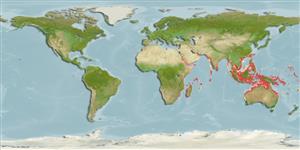Elasmobranchii (tubarões e raias) (sharks and rays) >
Myliobatiformes (Stingrays) >
Dasyatidae (Stingrays) > Urogymninae
Etymology: Pateobatis: Combination of Latin 'pateo' for 'lie open, be exposed' and 'batis' for skate, ray or flatfish; referring to the eclectic nature of members of this group.
Eponymy: James Travis Jenkins (1876–1959) was an ichthyologist who became Fishery Advisor to the Government of Bengal. [...] (Ref. 128868), visit book page.
Environment: milieu / climate zone / depth range / distribution range
Ecologia
marinhas; estuarina demersal; intervalo de profundidade 33 - 50 m (Ref. 9840). Tropical; 26°N - 32°S
Indo-Pacific: South Africa to New Guinea; north to the Philippines.
Comprimento de primeira maturação / Tamanho / Peso / Idade
Maturity: Lm 70.0 range ? - ? cm
Max length : 130 cm WD macho/indeterminado; (Ref. 11228); 110.8 cm WD (female)
Found inshore, on sandy substrates (Ref. 9840, 75154) to depths of 50m (Ref.58048). Inhabits shallow coastal waters (Ref. 45255). Ovoviviparous (Ref. 50449). Common catch of the demersal tangle net, bottom trawl and, occasionally, longline fisheries. Utilized for its meat, skin (very high value) and cartilage (Ref.58048). Max. Length of female given in Ref. 74367.
Ciclo de vida ou comportamento de acasalamento
Maturidade | Reprodução | Desova | Ovos | Fecundidade | Larvas
Exhibit ovoviparity (aplacental viviparity), with embryos feeding initially on yolk, then receiving additional nourishment from the mother by indirect absorption of uterine fluid enriched with mucus, fat or protein through specialised structures (Ref. 50449). Distinct pairing with embrace (Ref. 205).
Last, P.R. and J.D. Stevens, 1994. Sharks and rays of Australia. CSIRO, Australia. 513 p. (Ref. 6871)
Status na Lista Vermelha da UICN (Ref. 130435: Version 2024-1)
Ameaça para os humanos
Harmless
Uso pelos humanos
Pescarias: espécies comerciais
Ferramentas
Relatórios especiais
Baixar XML
Fontes da internet
Estimates based on models
Preferred temperature (Ref.
123201): 24.9 - 28.6, mean 27.8 °C (based on 168 cells).
Índice de diversidade filogenética (Ref.
82804): PD
50 = 0.5312 [Uniqueness, from 0.5 = low to 2.0 = high].
Bayesian length-weight: a=0.01023 (0.00486 - 0.02155), b=3.06 (2.87 - 3.25), in cm total length, based on LWR estimates for this (Sub)family-body shape (Ref.
93245).
Nível Trófico (Ref.
69278): 3.5 ±0.5 se; based on size and trophs of closest relatives
Resiliência (Ref.
120179): Baixo, tempo mínimo de duplicação da população 4,5 - 14 anos (Assuming fecundity<100).
Fishing Vulnerability (Ref.
59153): Very high vulnerability (90 of 100).
Nutrients (Ref.
124155): Calcium = 30.6 [7.4, 139.8] mg/100g; Iron = 0.744 [0.185, 1.949] mg/100g; Protein = 22 [19, 25] %; Omega3 = 0.165 [0.047, 0.480] g/100g; Selenium = 43.1 [11.5, 117.9] μg/100g; VitaminA = 11.1 [4.9, 24.6] μg/100g; Zinc = 1.01 [0.49, 1.82] mg/100g (wet weight);
